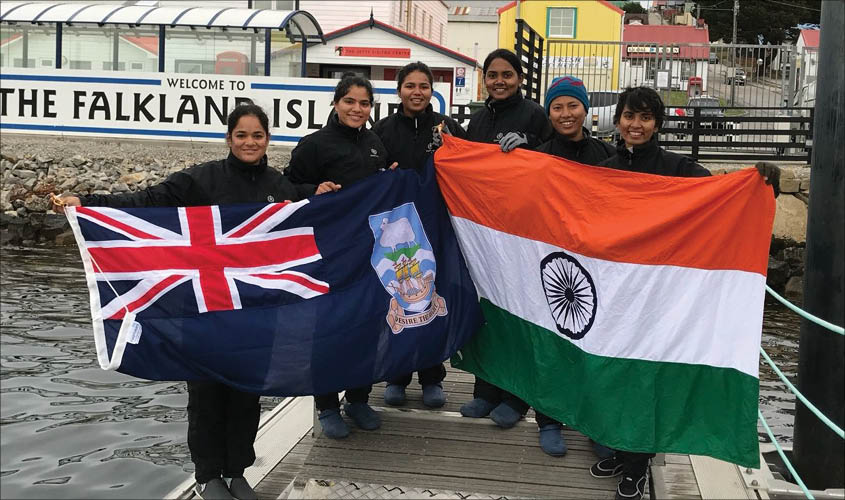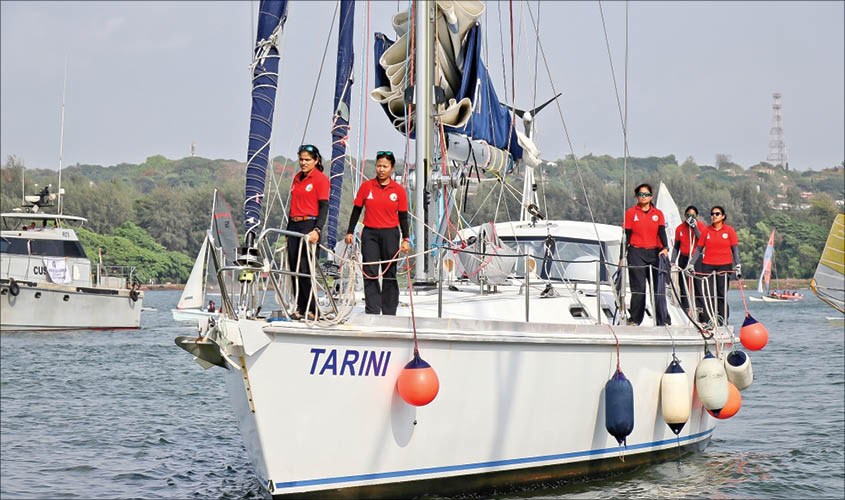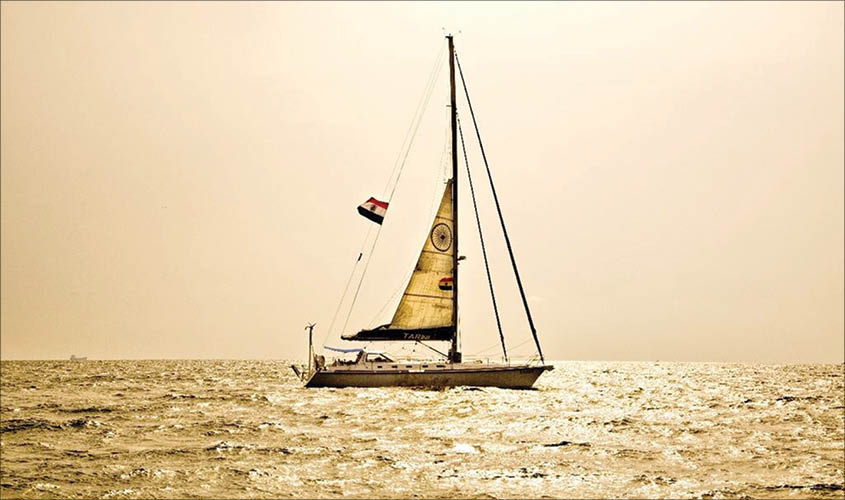In September 2017, six women officers of the Indian Navy set out from the coast of Goa on an ambitious expedition, aiming to circumnavigate the globe on a wind-powered sailboat named INSV Tarini. Eight months and around 22,000 nautical miles later, they concluded their epic journey and became the first all-female crew from India to accomplish this rare maritime feat. This is their story. By Bulbul Sharma.
“A perfect storm is the turning point in a sailor’s life,” said the late Manohar Prahlad Awati, who was an admiral and the chief of India’s Western Naval Command. He was also the visionary behind the Navika Sagar Parikrama, an Indian Navy project under which six women officers circumnavigated the globe in 254 days.
The expedition was flagged off by Defence Minister Nirmala Sitharaman in Goa on 10 September 2017. The six-member crew returned, after a journey of some 22,000 nautical miles, to their point of origin on 21 May 2018.
This was not only the first ever all-female team from India to circumnavigate the globe, but also the first all-female military team in the world to complete such a voyage.
The “serendipitous six”, as Admiral Awati used to call them, included Lieutenant Commander Vartika Joshi, Lt. Cdr. P. Swathi, Lt. Shougrakpam Vijaya, Lt. Aishwarya Boddapati, Lt. Payal Gupta and Lt. Cdr. Pratibha Jamwal. The journey was carried out on a simple sailboat, named the INSV Tarini. This Indian Navy sailing vessel is 17 metres long, has a mast height of 25 metres and has five sails. It was made in Goa using Dutch design principles, making the achievement of the crew all the more remarkable for being a purely indigenous effort. But why was this basic boat used for this extremely dangerous expedition?
Pratibha Jamwal told Guardian 20 that theirs was a wind-powered circumnavigation of the globe, for which a sail boat rather than a motor vessel had to be used.
Their sailboat, although fitted with state-of-the-art navigation and communication equipment, had no basic facilities on board, such as ACs, refrigerators etc.
“It was an adventure activity,” Jamwal said. “We had a water tank, with a capacity of only 600 litres. We crossed temperatures of 50 degrees and we have witnessed minus seven degrees as well. There was no heater on board.”

Lt. Cdr. Vartika Joshi at the Falkland Islands on 22 Janauary 2018. IANS
During the expedition they had four stopover points, and one unplanned break in Mauritius. The boat covered the Indian Ocean, Pacific Ocean and Atlantic Ocean, and went across three great capes, Cape Leeuwin, Cape Horn and Cape of Good Hope.
The overall journey was divided into four legs. In the first leg, the team covered a distance of 9,260km, from Goa to Freemantle on the west coast of Australia. The second leg unfolded across the Tasman Sea, ending in New Zealand. The third leg was the longest, covering 10,556.4km, across the stormy South Pacific Ocean, taking them from Cape Horn to Falklands in South America. The fourth and final leg stretched from the Atlantic Ocean to South Africa and back to the starting point in Goa.
Each leg posed its own set of challenges for the Tarini crew. In the early phases of their journey, they were often stuck in the calm waters of the Indian Ocean near the equator, with little to no wind to propel them forward. At this point, their water purifying system had also stopped working and they were left with no other option but to use their emergency supplies of water.
Each crew member during that time had to limit her water consumption to 1-1.5 litres for the entire day. Some months into their journey, the team encountered another serious problem, this time with the mast, which could only be fixed manually and required one of the team members to climb the 25-meter-high mast and fix the broken rigging. Vartika Joshi, being the skipper and the most experienced of all, rose up to the challenge, climbing an almost eight-floor-high mast to resolve the issue that could have led to a perilous situation in the windy Tasman Sea.
Then, in the third leg, they finally encountered their “perfect storm”. While the crew had a fool-proof strategy in place, their boat, INSV Tarini, still got caught in the tail of the storm.
They had to brave the storm in the South Pacific Ocean for a few days before they could finally break free. With the waves rising up to 5-6 metres, Joshi nearly escaped a life-threatening situation. She found herself caught in one such massive wave for 10-15 seconds, struggling to regain her balance and hold onto the steering wheel.

According to Shougrakpam Vijaya, “It was a hurricane-face storm and it was almost 120 km/hr. We somehow managed to be caught in the tail of the storm and not in its eye, and that’s why we escaped it. If we had committed even the slightest mistake, the boat would have been capsized. But we all worked together and took care of the situation.”
On the final stretch of their journey, they encountered one more crisis. One of the boat’s steering wheels had its connection with the rudder broken.
Only one out of the two steering wheels was now working. So they had to make an unplanned stop at Port Louis in Mauritius for the repair. The part to be replaced was flown in from India and it took the crew eight days before they could resume the voyage.
Driven solely by their appetite for adventure, the six women officers were among the 25-30 personnel who had applied to participate in the expedition.
Because of the kind of dedication and time the project demanded, it was strictly a volunteer-based programme. Jamwal said, “Since circumnavigation involves many life-threatening situations, you cannot nominate people to go on expeditions like these. And since this was going to take a lot of time and everything in our lives had to be held back till the time we were done with the expedition, we had to keep our personal lives aside. When the Navy asked us, there were about 25-30 officers who volunteered. After that, there was a screening and six of us got selected. But mainly, it was a matter of personal choice. Many officers even backed out after understanding the level of commitment that was required.”
The crew trained for more than two-and-a-half years and were mentored by Captain Dilip Donde, the first Indian to solo circumnavigate the globe in 276 days in 2010. Their training focussed on learning both the theoretical and practical aspects of sailing. They also went on short voyages to Mauritius and Cape Town during this time. Aishwarya Boddapati, a Tarini crew member, said, “We had to learn everything anyone should about ocean sailing—from navigating a boat and meteorology to seamanship. This was part of the theoretical training. And our practical training involved learning how to operate and repair on-board instruments.”

A long sailing expedition can be mentally taxing for even the experienced sailors. To keep their spirits up, the crew members would talk to their family daily, with the help of a satellite phone they were carrying. The boat was also fitted with Wi-Fi but due to the costs involved (Rs 10,000-15,000 for every 10 seconds) it had to be used judiciously. They also had to maintain a record of each MB of data that was used.
To prepare for the voyage, the crew sought inspiration from their precursors—sailors who had taken up and completed similar adventures. One particular experience that inspired them the most was that of their trainer Dilip Donde. Boddapati said, “Before I started my journey, I got a book called The First Indian, based on the circumnavigation experience of Captain Dilip Donde. I read the book… And I was so fascinated by him when I met him. I always draw inspiration from him.”
To this, Jamwal added, “When we volunteered, we were first told to leave our genders behind. Circumnavigation itself is such a hard thing that you need not complicate it more by adding your gender to it… Our mentor Captain Dilip was the first Indian to circumnavigate the globe. He was the one who started from scratch and he was the one who was in front of us. So he was an inspiration for us.”
Amid all the looming dangers and the mundane daily chores on the boat, they made time for leisure—with celebrations, birthday parties. The surrounding scenery, the awe-inspiring seascape with its marine life, was another source of comfort. During the voyage, the crew was also wished by Prime Minister Narendra Modi on their birthdays.
Jamwal said, “You cannot compromise on the fun part because that keeps you going. Every now and then, there were many good moments. We celebrated a lot of things, even our birthdays. Baking cakes was something that happened quite often because we used to celebrate every small thing.”
When asked if any of them plans to go on a solo circumnavigation journey anytime soon, Jamwal answered that such a decision would require a lot of forethought, as well as serious commitment.
She said, “We will think about it. It cannot be a random decision because the kind of commitment it requires is big. Even though we have circumnavigated, we still need to learn a lot if we have to circumnavigate solo. And it also depends on time, if we can dedicate another two-three years then we will go ahead. We all want to go to the sea, not necessarily for circumnavigation but we want to go for the races. There are many open ocean races that keep happening and Indian Navy participates in those.”
Each crew member now awaits another adventure on the sea and revealed that for them sailing is like an “addiction”. Team Tarini member, Payal Gupta said, “One big specialty of a sailor is that once you are used to sailing, you don’t want to come back to land. It is like a sport and you never want to stop playing.”
It’s now almost one year since their return from this voyage. On 8 March, to mark the International Women’s Day, the National Geographic channel released a 45-minute documentary based on Team Tarini’s circumnavigation experience. To promote the film, Nat Geo also conducted a social media campaign, #GirlsWhoSailed, encouraging people to share stories of their personal struggles.
A special screening of the documentary was held on 6 March at Delhi University’s Lady Shri Ram College for Women. The screening was attended by Chief of the Naval Staff, Admiral Sunil Lanba, along with other dignitaries.
Admiral Lanba congratulated the women officers on the successful completion of their expedition and said, “During the long voyage the crew demonstrated unfaltering resolve and solid fortitude as they faced challenging conditions. And in doing so they have joined an illustrious league of women whose accomplishments have added to the discourse of women’s empowerment in our country. The expedition has showcased nari shakti on the world platform and has done the nation proud, by not only showing Indian flag at distant shores but also by demonstrating their sea-sailing capabilities… Today these brilliant young officers are role models and their achievement serves as an inspiration to everyone.”

